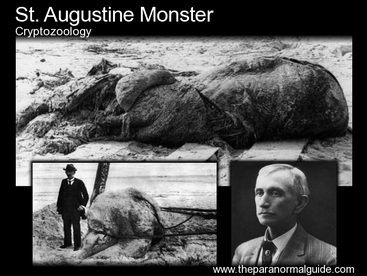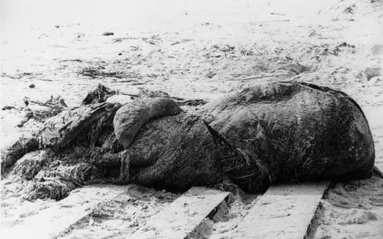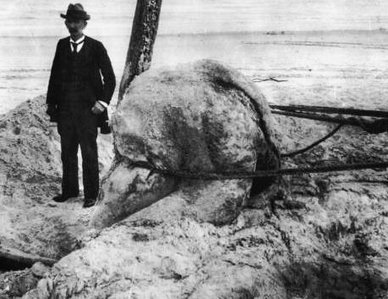
The St. Augustine Monster is an example of a mysterious "cryptid" that has divided Zoology and, for a time, mystified the world.
In the Deep
Whether its the remains of long submerged vessels, human skeletal parts or trinkets from pirate bounty, there has been and will always be things that find their way onto our shores, having travelled many miles to be found, studied and classified by science, historians or mystery enthusiasts.
The St. Augustine Monster
 The blob like "monster"
The blob like "monster" The two boys told a local physician of their discovery and he, Dr. DeWitt Webb, examined the carcass the following day. He noted that it was of a pale pinkish colour, almost white and had a silvery reflection in the sunlight. He deducted that its was a very mutilated and rapidly decomposing animal, speculating it was an abnormally large octopus, as it appeared to have had visible stumps of possibly four tentacles. He estimated it weighed at least five tons, it was nearly six metres long and about two-and-a-half metres wide.
A few days later the remains were photographed, however they were never published and considered lost for many years. Drawings of the mass inspired by the pictures, made by zoologist, author and explorer Alpheus Hyatt Verrill, were for many years the only known records of the find until they were discovered in 1993.
 Webb with the remains.
Webb with the remains. The carcass was moved further inland closer to St. Augustine after a storm tide had dragged it out to sea, it having washed ashore again soon after near its original location. It attracted a lot of tourists to the area, but the fate of the carcass remains unknown.
Verrill soon after announced the "blob" was nothing more than the upper remains of a sperm whale, and it is here that the great debate, and divide, in the zoology community began in regards to the identity of the "monster". Samples of the carcass still survive today, and over the years a number of biologists and cryptozoologists have, since the 1970's, analysed the samples using the technology available at the time and in most cases the findings support the Octopus giganteus conclusion. However, as of recent times, biologists have claimed its nothing more than whale blubber, tissue comprised mainly of collagen.
Decomposing Whale Matter
 Dr DeWitt Webb.
Dr DeWitt Webb. Many cryptozoologists maintain the evidence supports the existence of legendary creatures like the Lusca, a massive octopus or octopi said to inhabit blow-holes near an island in the Bahamas.
Science may tell us the St. Augustine Monster was nothing more than decomposing whale matter, but many still believe that it was proof of huge sea monsters, washed ashore to remind us humans once again the sea has many mysteries and horrors waiting to be discovered.
Put together by Ashley Hall 2014





 RSS Feed
RSS Feed
